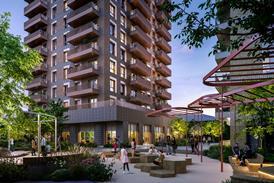Ben Derbyshire looks to Italy for inspiration on how to revive struggling town centres

As a student in the early seventies, I was greatly influenced by the sixties plan to recreate the old town of Bologna for a new society: Città Vecchia, Nuova Società.
A programme of renovation was undertaken in the town centre as a whole, not just its heritage buildings, employing conservation as means of ‘reappropriation of the city’, particularly for social housing. Quality of renovation was regulated by strict code requirements linked to a grant programme. The grant scheme encouraged landlords to accommodate existing tenants or applicants from the waiting list. If landlords wanted to sell, the city had first refusal to purchase at a reduced rate.
Today, Bologna has not escaped gentrification and the architect of the project, planner and councillor Pier Luigi Cervellati, has lamented that ‘without the public ownership of land there can be no real socialist land policy.’ Yet according to Tess Pinto, writing in Tribune, the programme was nonetheless successful - compared to cities like Rome and Milan, Bologna still houses a significant residential population within its city walls, and retains a palpable sense of a thriving local culture.
In recent years, as I’ve been privileged to visit and learn something of the plight of town centres in English towns not dissimilar to Bologna, this exemplar comes back to me with ever increasing resonance.
“Town centres play a pivotal role in community wellbeing. They act as the physical embodiment of civic pride and cohesion”
Each town is unique and remarkable in its own way with histories evident in surviving heritage, but they also share some common issues. The process of decline is patchy, with bright spots that buck the trend, but vacancy rates of shops, commercial and residential premises can be very high – up to 50%. Crime rates and fear of crime result in low footfall, and this is often compounded after dark by street sleepers, substance abusers and an absence of night-time economy. Economic activity, entrepreneurship and cultural activity are often in decline or sometimes completely absent.
Town centres play a pivotal role in community wellbeing. They act as the physical embodiment of civic pride and cohesion. The downside of town centre abandonment powerfully signifies social and economic collapse. So there is surely a case for switching our strategy for public investment in housing sufficient to create our own version of ‘old town, new society’.
It’s not as if the last government ignored the issue of town centre decline. There was £12 billion for affordable housing, the £4.8 billion Levelling Up Fund and a £2.6 billion Shared Prosperity Fund, DLUHC’s £1.5 billion Brownfield Fund and a £1.5 billion Levelling Up Home Building Fund.
Historic England benefitted from £95m from DCMS for the four year High Street Heritage Action Zone project across 67 high streets combining capital investment, community engagement and cultural programming. High Street Rental Auctions would have allowed local authorities to take control of empty properties blighting their high streets and rent them out to local businesses. Less helpfully, Permitted Development Rights were extended under the Conservatives, resulting in countless poor quality adaptations that will blight our towns for years to come.
“I hope that some of this policy innovation will be applied to releasing the immense potential of grassroots cultural and arts programmes for town centres. There is nothing more damaging for our built heritage then emptiness. Local people have the capacity to fill vacant space aplenty.”
The Labour party’s manifesto promises to get Britain building again, take back our streets, rejuvenating high streets and bringing economic growth back to towns across the country. Key promises are to tackle anti-social behaviour and shoplifting, roll out banking hubs, replace business rates, revamp empty shops, pubs and community spaces with a strong new ‘right to buy’ for beloved community assets. All of that is in addition to Labour’s plans to enhance compulsory purchase legislation, build back planning departments and invest in new and renovated homes.
I hope that some of this policy innovation will be applied to releasing the immense potential of grassroots cultural and arts programmes for town centres. There is nothing more damaging for our built heritage then emptiness. Local people have the capacity to fill vacant space aplenty.
>> Also read: What makes a successful new town?
I know from experience how transformative this can be. Our own Assemble & Join programme at HTA Design engages local people in decisions about public art where they live, work and shop. It is an innovative means of public engagement, a simple idea that puts CNC technology to use and continues to be popular. There are many similar examples of catalytic community activity identifying and re-using vacant space: Local Listing campaigns, Bringing Nature Home, Urban Rooms, Live Music Now. No need to describe these in detail – you get what you see on the tin!
Yet, my experience tells me we need more than this to successfully counteract the catastrophic impact of online and out-of-town retail.
We need the kind of fiscal policy innovation being promoted by the Don’t Waste Buildings campaign – equalising VAT on renovation and new-build, incentives linked to an enhanced Energy Performance Certificate system and so on. We need policies that compel institutional investors to make thousands of vacant properties fit for occupation.
We do not need to be revolutionary to learn from Bologna, nicknamed La Dotta, La Grassa, La Rossa (The learned, The epicurean, The red). But how wonderful it would be to take a leaf of out the city’s play book and implement a Homes England sponsored programme – a contemporary British Città Vecchia, Nuova Società?
Postscript
Ben Derbyshire is chair of HTA Design and former president of RIBA
















No comments yet